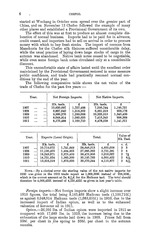| 1 |
 |
“...065,422/.)
in 1910 (see note on page 6), showing an increase over 1910 of 374,761
Haikuan taels (50,455/.), which, considering the highly adverse con-
ditions which prevailed during the greater part of the year, tends to
show that the trade of Chefoo rests on a solid foundation and only
needs a little of the encouragement which has so far been withheld
to enable it to expand naturally to its true proportions.
The outbreak of a severe epidemic of pneumonic plague, which
reached Chefoo from Manchuria, whence it was brought by coolies
returning to their homes for the Chinese New Year, and lasted
from early in January until the middle, of April, resulted in the
almost complete isolation of the port, and consequent stagnation of
trade during three and a half months, owing to the stringent
quarantine measures it was thought necessary to adopt before the
real nature of the disease and the proper preventive means had been
ascertained. It has, however, since been established that such severe
r...”
|
|
| 2 |
 |
“...6
CHEFOO.
started at Wuchang in October soon spread over the greater part of
China, and on November 13 Chefoo followed the example of many
other places and established a Provisional Government of its own.
The effect of this was at first to produce an almost complete dis-
location of normal business. Imports had to be paid for in advance,
credit ceased, and importers had to sell on arrival in order to procure
money with which to buy fresh stocks. The import of cocoons from
Manchuria for the Chefoo silk filatures suffered considerable delay,
while the usual practice of laying down large stocks of cargo in the
autumn was abandoned. Native bank notes ceased to be negotiable,
while even some foreign bank notes circulated only at a considerable
discount.
This uncomfortable state of affairs lasted until the excellent order
maintained by the Provisional Government restored in some measure
public confidence, and trade had practically resumed normal con-
ditions by the end of the year.
The following...”
|
|
| 3 |
 |
“...British-American Tobacco Com-
pany's wares.
Flour.—The phenomenal import of flour in 1911, which amounted
to 119,922 cwts. as against 4,039 cwts. in 1910 and 1,810 cwts. in
1909, was clue to the failure of the harvest and consequent dearth of
foodstuffs.
Sugar.—1911 proved a poor year for foreign sugar owing to a rise
in price from 7 taels (18s. 10c?.) to 9 taels (1?. 4s.) per picul (133^ lbs.),
which led to a. larger business being done in native sugar.
Cocoons.—The import of cocoon3 from Manchuria for the Chefoo
filatures was slightly larger than in 1909, but the cocoons were
smaller and did not unreel so much silk. The autumn crop of
cocoons is estimated at about 85,000 baskets, each containing on the
average 35,000 to 40,000 cocoons. Prices per 1.000 cocoons ranged...”
|
|